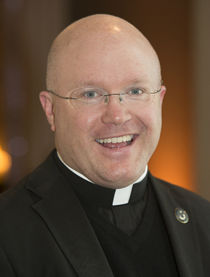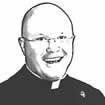
Faith

Landry
Last week I was asked by a 25-year-old co-worker whether I was intending to see Spotlight, the movie detailing The Boston Globe's investigative team's month's long Pulitzer-prize winning examination of the clergy sexual abuse of minors in the Archdiocese of Boston. She wanted to see the movie's portrayal of the Church but worried whether doing so might be subsidizing anti-Catholicism.
I was planning to go to see the movie, I told her, both so that I might be able to respond to the various questions I was being asked by those who had already seen it as well as out of a sense of witness and reparation. When she asked me to elaborate about the latter, I said that I thought it would be important for movie-goers to see a priest to convey that the Church isn't in denial about the evils committed and also to give them an opportunity to focus their anger if they should choose.
"You're going to go dressed as a priest?," she exclaimed, evidently worried about my safety. I replied that for a priest, clerical garb is like a wedding ring for married people, an external sign of sacramental identity, and that I had no desire to go undercover. Since 2002, I told her, I had gotten used to the occasional opprobrium, unprovoked insults, and, on a few occasions, spittle that have come to priests as a result of the abominations of some of our brothers, but that it's important for priests to be able to take that suffering as co-redeemers with Christ, offering whatever comes up for victims and for the Church.
"Well, can I at least come with you?," she protectively asked. I told her that that last thing that people needed was to see a priest accompanied by an attractive young woman to a movie on Saturday night!
So alone I went to see Spotlight, plopping down $15, the going rate for movies in Manhattan. I was surprised to see the rather large theater half-full for a 6 pm showing and, although no one should be startled to see young people at a movie on a Saturday night, I was somewhat shocked that so many older teens and young adults had chosen to come to a movie about journalists covering clergy sex abuse when there were 15 other theaters simultaneously showing more traditional Hollywood fare.
I anticipated that Spotlight would be a rather one-sided portrayal pitting saintly scribes against corrupt churchmen. But it was far from a caricature. And there were also many instances of gratuitous fairness and balance.
It introduced Cardinal Law not as a villain but as a civil rights hero willing to suffer as a young Catholic newspaper editor for his defense of the dignity and rights of black Americans and someone whose words after 9/11 drew rapt attention and positive reviews from the Globe newsroom.
The movie also went out of its way to portray the Church positively on various occasions when it didn't have to: showing a packed Church rather than an empty one; a young, enthusiastic priest rather than someone tired and old; the piety of a faithful grandmother and the lively participation of children; the love of the Church and her good name on the part of Catholic police officers, lawyers, businessmen and others; and a vibrant appreciation of the Church's charitable work.
It clearly showed both the virtues and the flaws of two of the victims' attorneys, revealing the volatility and evident human weaknesses of one and the slick complicity of another, and didn't hide the fact that they take a third of whatever the victims receive in settlements.
The movie even featured, as a subtext of the drama, multiple references to how the Globe had failed to treat with requisite seriousness the situation of the clerical sexual abuse of minors after a victim and a victim's attorney had given substantial information to the newspaper in the 90s.
David F. Pierre's new book, Sins of the Press: The Untold Story of The Boston Globe's Reporting on Sex Abuse in the Catholic Church, adds many more details in fair criticism of the Globe's general coverage of sex abuse: the double-standard in the way the newspaper covered the Church versus sex abuse in public schools; an advice columnist's repeated, non-judgmental words about sex between teachers and high school students; its praise for the psychological treatment of abusive priests that it would later castigate; its praise of a Boston street priest and his renegade ideas on sexuality who later turned out to be a serial abuser; its positive presentation of the foundation of NAMBLA; its encomia for several other child molesters, like Roman Polanski, even after proven allegations of abuse.
None of Pierre's important criticism, however, invalidates the facts the Globe brought to light with regard to the Church's obviously inadequate response to the sexual abuse of minors. While the Church ought to be treated by the same legal standard as all other institutions, I want it to be held to a higher moral standard. It was nevertheless noteworthy for Spotlight to show the Globe's own learning curve on the issue, which contextualizes the learning curve of leaders in the Archdiocese of Boston.
There were a couple of things I didn't appreciate.
I didn't like the fact that Spotlight treated Richard Sipe as a sage advisor behind a telephonic curtain and uncritically presented as fact his biased research on priestly celibacy -- accusing fifty percent of being unfaithful, and trying to link celibacy to abuse -- although the movie did mention twice that he had left the priesthood to marry a religious sister and was therefore not a dispassionate scholar.
I also thought the movie's final word was inadequate: after mentioning Cardinal Law's resignation and running a lengthy scroll of all of the dioceses in the world with abuse allegations against its priests -- most, to some degree, coming to light only after the Spotlight report revealed systemic inadequacies in the Church's vigilance of clergy and care for victims -- it could have easily mentioned another part of Spotlight's legacy, that since 2002, the Church in the US has gotten its act together in removing abusive priests hastily, initiating investigations, caring for victims, and ensuring safe environments.
As I was leaving the theater, three boys on the escalator, juniors or seniors in high school, spotted me and waited at the bottom for me to approach. I emotionally braced myself for what they might say. With a thick New York accent, one asked something that surprised me: "Was all of that true, Father?"
"While it obviously left many parts of the story out, both good and bad," I replied, "yes, boys, the movie is, sadly, substantially true."
They paused for a few seconds to digest the information.
Then one of them said to me with tender sincerity, "Thanks, Father," and shook my hand. The other two, looking me in the eye, did likewise.
They didn't state why they were thanking me, but it seemed to be more than for just answering their question.
It was for me a sign of hope that even after they had spent two hours being exposed to a portrayal of the worst of ecclesiastical filth, they still grasped that the Church and the priesthood cannot be defined by those who fail to practice what the Church preaches and Christ commanded, that the Spotlight coming from the Light of the World was still illuminating in the midst of darkness.
- Father Roger J. Landry is a priest of the Diocese of Fall River, Massachusetts, who works for the Holy See’s Permanent Observer Mission to the United Nations.
Recent articles in the Faith & Family section
-
Beauty comes to Ordinary TimeLucia A. Silecchia
-
Could Jesus sin? If not, was he truly human and free?Jenna Marie Cooper
-
AdventFather Robert M. O'Grady
-
Rejoice always!Archbishop Richard Henning
-
Making a Big Difference in a Small WayMaureen Crowley Heil


















